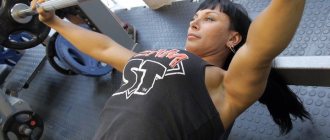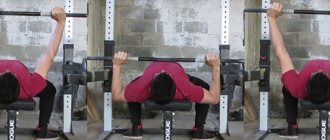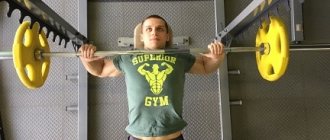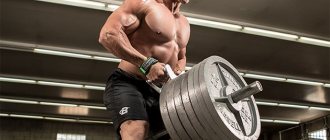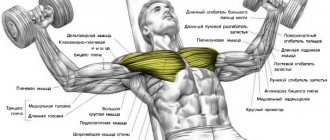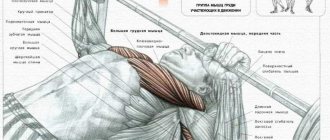What regulations and rules are provided in the AWPC federation? How is it different from WPC? How to avoid disqualification? Can amateur athletes get a sports rank? Read the answers to these questions in this article.
AWPC is a powerlifting federation that conducts sports competitions at the international level among strength disciplines, including the bench press. This organization is an amateur branch of the WPC and has a number of characteristic features. Therefore, the AWPC bench press standards differ from other federations.
BARREL PRESS OWN WEIGHT (MEN)
(number of repetitions per approach)
| Weight category (kilogram) | Elite | MSMK | MS | KMS | I | II | III |
| 52 | 53 | 45 | 40 | 35 | 27 | 23 | 20 |
| 56 | 52 | 44 | 39 | 35 | 26 | 22 | 19 |
| 60 | 51 | 43 | 38 | 34 | 26 | 21 | 18 |
| 67.5 | 50 | 42 | 37 | 32 | 25 | 20 | 17 |
| 75 | 48 | 40 | 35 | 31 | 25 | 20 | 16 |
| 82.5 | 46 | 38 | 33 | 29 | 22 | 19 | 15 |
| 90 | 45 | 37 | 31 | 27 | 21 | 18 | 14 |
| 100 | 43 | 35 | 30 | 26 | 20 | 17 | 13 |
| 110 | 41 | 33 | 28 | 24 | 20 | 16 | 12 |
| 125 | 39 | 31 | 26 | 21 | 18 | 14 | 11 |
| 140 | 37 | 29 | 24 | 20 | 16 | 13 | 9 |
| 140 | 34 | 26 | 22 | 18 | 14 | 11 | 8 |
| Weight category (kilogram) | Iyu | IIyu | III |
| 52 | 30 | 25 | 20 |
| 56 | 29 | 24 | 19 |
| 60 | 28 | 23 | 18 |
| 67.5 | 27 | 22 | 17 |
| 75 | 26 | 21 | 16 |
| 82.5 | 25 | 20 | 15 |
| 90 | 24 | 19 | 14 |
| 100 | 23 | 18 | 13 |
| 110 | 22 | 17 | 12 |
| 125 | 21 | 16 | 11 |
| 140 | 20 | 16 | 10 |
| 140 | 19 | 15 | 9 |
Execution technique
If you are going to participate in competitions or receive a rank in this sports discipline, you must understand that the technique of performing the exercise will be slightly different. During a normal workout, you perform the exercise at a fairly fast pace. Perhaps, through trial and error, you found the optimal position of your hands and the trajectory of your elbows that is comfortable for you. However, the awpc approved prone technique will be different from what you are used to.
Awpc is a power sports federation . It establishes category standards for various strength exercises. This federation is amateur. Its standards are much lower than in other professional strength federations. For this reason, it is much easier to get a sports rank here than in other federations. The standards here are different, but the technique of execution is the same as in professional strength federations:
- Lie down on the bench. Your shoulders and buttocks should be touching the surface of the bench.
- You have the right to choose your own head position. However, it is better not to move her, because this can lead to injury.
- The feet should rest firmly on the floor. It is allowed to place discs from barbells under your feet.
- The grip width is determined by the athlete independently. At the bottom, your arms should be bent at an angle slightly less than 90 degrees. The main thing is that the grip width does not exceed 81 centimeters.
- The participant must have from two to four belayers. They have the right to help him remove the barbell from the racks. After which, the athlete can begin the approach.
- The bar should begin to move down after the “Start” command. The judge sits behind the head of the competitor, from where he can clearly see all the mistakes that the athlete makes.
- At the lowest point, you need to hold the barbell for 1 second. The main thing is not to put it on your chest. This is a gross violation of the rules, because of which you simply will not be counted for this attempt.
- After the athlete has completed the maximum possible number of times, he needs to fix the barbell at the top point. You must wait for the “Stand” command from the judge. After that, you can install the bar on the racks.
When working for one repetition, the bench press is performed according to the same principle. During competitions, the pace of execution is much slower than during normal training. Moreover, the judge closely monitors the technique .
Rules for performing bench press without equipment at WPF-KRAWA competitions
The rules by which the bench press is judged have been formed. In general they look like this:
- The bench must be installed on a special platform so that the stands are closer to the spectators and the chief judge.
- The athlete lies down on the bench so that his back completely touches its surface, and his head, shoulders and buttocks only partially. The legs are placed in such a way as to provide reliable support during the movement. The position of the body should remain unchanged throughout the exercise.
- If necessary, the athlete has the right to request the installation of special platforms under his feet. This is done if the athlete does not reach the floor with his feet.
- After the correct position is taken, assistants help the performer remove the bar from the racks.
- The grip width cannot exceed 81 centimeters. If an athlete’s grip is affected by any injuries or physiological characteristics, then he must inform the members of the panel of judges about this before the start of the performance.
- All stages of the press are performed at the command of the chief judge. This can be either a loud voice signal or a gesture previously agreed upon with the speaker. So the “press” command is given only after the barbell is firmly fixed on the chest. The stance command is given after the elbow joint is fully engaged.
- If an athlete has physiological defects in his elbows, unable to straighten them completely, then he must be notified of this before the start of the performance.
The barbell grip used in competitions deserves special mention. The most common is the so-called classic grip, but some athletes prefer the reverse grip, considering it more convenient. Especially for them, the official rules stipulated the ability to independently choose the most suitable grip style.
Naturally, the bench press is performed according to generally accepted and already classic rules. But it is worth separately highlighting the circumstances under which an attempt may be considered unsuccessful:
- Each competing athlete is required to follow the commands given by the chief judge of the competition. This means that failure to comply with signals, especially at the beginning and end of a movement, is considered a gross violation and leads to the cancellation of the results of the attempt.
- Before starting the movement, the athlete takes a certain starting position on the bench press bench. Subsequent changes in body position, such as lifting the buttocks or moving the hands along the surface of the bar, are considered grounds for declaring the attempt unsuccessful.
- It is not enough to simply get the elbow joint to engage; it must happen simultaneously for both arms. Otherwise, a “boost” will be recorded, which means the attempt is considered unsuccessful.
- After receiving the “press” command, the barbell can only move upward. This means that reaching a “dead point” or even a slight downward movement of the bar is grounds for declaring the attempt unsuccessful and stopping it.
- Assistants have the right to touch the apparatus only before the first and after the last command of the chief judge. The rest of the time, the barbell must be held and pressed exclusively by the athlete.
- Few people know, but athletes are prohibited from touching the bench or its supports with their feet. That is, only emphasis on the surface of the platform is allowed, without any contact with the bench, racks, and so on.
- After removing the barbell, it is forbidden to touch the racks with it until the exercise is completed, as this may make the movement easier.
It is important to emphasize that before the start of the competition, each athlete is obliged to familiarize himself with the full set of rules of the federation, because ignorance of certain points of the current regulations cannot exempt from their compliance and possible consequences.
General requirements
AWPC bench press without equipment includes a set of requirements that an athlete must comply with in order to record the set result and receive a rank. The list of mandatory norms includes a ban on:
- the use of oils, ointments and other lubricants on the body or sports equipment (with the exception of therapeutic ointments and rubbing);
- treating the bench or bar with third-party substances;
- use of dirty clothing or equipment during exercise;
- the use of obscene language or various methods of “psychostimulation”.
If the above rules are not followed, the athlete may be removed from the competition. Referees use light signals to convey messages and commands. Immediately before competitions, athletes’ clothing and equipment are checked for compliance with the necessary standards.
For participants in AWPC competitions, there are standard requirements for the technique and rules of performing the bench press, as well as a list of reasons for which exclusion is possible. Disqualification or non-registration is recorded when:
- violation of the starting position;
- deliberate non-compliance with the rules;
- oversight or minor error.
Athletes are divided into groups and then perform exercises following a round system. During national, international and world championships, it is possible to record records. Athletes can familiarize themselves with the current regulations in advance. To provide information to competing women and men, a table of bench presses without equipment and with additional equipment is provided.
BARREL PRESS OWN WEIGHT (WOMEN)
| Weight category (kilogram) | MSMK | MS |
| 44 | 22 | 18 |
| 48 | 21 | 17 |
| 52 | 20 | 16 |
| 56 | 19 | 15 |
| 60 | 18 | 14 |
| 67.5 | 17 | 13 |
| 75 | 16 | 12 |
| 82.5 | 15 | 11 |
| 90 | 14 | 10 |
| 90 | 12 | 9 |
| Weight category (kilogram) | KMS | I | II | III |
| 44 | 47 | 37 | 28 | 19 |
| 48 | 46 | 36 | 27 | 18 |
| 52 | 45 | 35 | 26 | 17 |
| 56 | 44 | 34 | 25 | 16 |
| 60 | 43 | 33 | 24 | 15 |
| 67.5 | 42 | 32 | 23 | 14 |
| 75 | 41 | 31 | 22 | 13 |
| 82.5 | 40 | 30 | 21 | 12 |
| 90 | 38 | 28 | 20 | 11 |
| 90 | 37 | 27 | 18 | 9 |
MSMK - Master of Sports of International Class MS - Master of Sports KMS - Candidate Master of Sports I - first category II - second category III - third category I(u) - first youth category II(u) - second youth category III(u) - third youth category
| 1. | The sports title Master of Sports of international class WPC in folk press and below is awarded at Russian Championships and Cups, master tournaments and international competitions, subject to compliance with the standards for folk press. |
| 2. | The sports title Master of Sports WPC in folk bench press and below is awarded at regional, regional and city competitions, Championships, tournaments, championships and Cups, subject to compliance with standards for folk bench press. |
| 3. | Sports category KMS, 1, 2 and 3 sports category WPC in folk bench press are assigned at regional or intra-club competitions, Championships, tournaments, championships and Cups, subject to compliance with the standards for folk bench press. |
Discussion on the forum (comments: 5)
Article added: 2015-05-24
| Standards for the bench press (without equipment) Table of rank standards for the bench press, without equipment (WPC, AWPC) Calculation of the one-time maximum in the bench press Calculator for calculating the bench press (maximum weight in the bench press) Standards for the squat with a barbell (without equipment) )Table of rank standards for squats with a barbell, without equipment (federations IPA, IPA-A) Standards for deadlift (without equipment) Table of rank standards for deadlift without equipment (AWPC, WPC) Standards for powersports (standing press, biceps curl ) Table of standards for standing barbell press and biceps curl (powersport - biathlon) Standards for powerlifting, table of ranks Official standards in powerlifting, table of ranks and norms (2018-2021) Rank standards for bodybuilding Table of standards for bodybuilding for I-III categories, CMS , MS, MSMK (for 2021 – 2021) |
Distinctive features of AWPC and WPC
World Powerlifting Congress, better known by its acronym WPC, is a World Powerlifting Congress that has existed since 1986. The members of this organization are athletes from 30 countries. The main tasks of the WPC include:
- formation of rules for holding powerlifting competitions;
- selection of conditions for further promotion of the sport;
- establishing standards that athletes must pass to receive a rank;
- organizing and monitoring the competition process.
Amateur World Powerlifting Congress, or AWPC, is an organization that is part of the WPC structure, but has more relaxed requirements. The Federation was created in 1999 to provide amateur athletes with the opportunity to take part in powerlifting competitions. The main differences between AWPC and WPC include:
- the presence of doping control affecting only 10% of competitors;
- participation of athletes with 2 to 3 years of experience in powerlifting;
- lower standards for receiving a rank.
Typically, athletes who compete in AWPC competitions weigh less than professional powerlifters because they do not use nutritional or chemical supplements to gain muscle mass.
With or without equipment?
The awpc federation provides two implementation options:
- With equipment.
- No equipment.
Equipment for the bench press - special single-layer and multi-layer T-shirts. They are made of very dense material, which, due to its physical properties, helps the athlete lift more weight.
A single-layer T-shirt can help you increase your working weight by 10-15 kilograms, and a multi-layer T-shirt by 30-40 kilograms. This depends on the material of the product, as well as on the individual characteristics of the athlete. Accordingly, the standards with and without equipment, for the same category, will be different. For example, to obtain KMS in the bench press, a man weighing 60 kilograms without equipment needs to press a barbell weighing 90 kilograms. And with equipment, the weight of the barbell should be 105 kilograms .
The awpc federation has developed tables of category standards for the bench press without equipment:
Check out this table and evaluate your strengths. Perhaps you are already able to fulfill some category standard. This table shows the barbell weights to perform one repetition per set.


